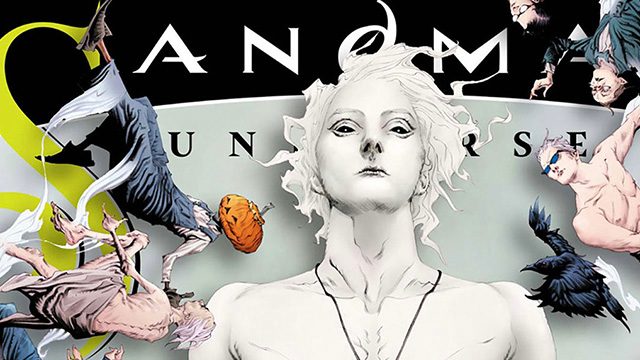SUMMARY
This is AI generated summarization, which may have errors. For context, always refer to the full article.

MANILA, Philippines — For a generation of comic book fans, Neil Gaiman’s The Sandman was their introduction to “grown-up” comics. The Sandman — along with other seminal works such as Alan Moore’s Watchmen and Art Spiegelman’s Maus — completely redefined the medium.
Gaiman’s other works have been adapted to film and TV, but The Sandman has so far eluded the TV or movie treatment. All that will change if the planned Netflix series pushes through. Unlike previous attempts, there seems to be serious momentum behind this one. As expected, comic fans are hyped.
If you’d like to get into The Sandman, here’s a guide designed to help you navigate this strange and intriguing world.
Into The Dreaming
The Sandman focuses on Dream, who is called by many names in the books, the most common of which is Morpheus. He presides over The Dreaming, a realm we all visit in our dreams, and its various denizens.
Morpheus, a brooding, melancholic figure reminiscent of Robert Smith and David Bowie, is the literal embodiment of dreams. Gaiman expanded the concept of dreaming to include storytelling and artistic (specifically, literary) inspiration. Morpheus is one of the seven Endless siblings, each of whom embodies an aspect of life: Dream, Death, Desire, Destiny, Delirium, Despair, and Destruction.
You’d think being endless and all would make one above petty squabbling, but the opposite is true. As a family unit, the Endless are as dysfunctional as any mortal family. Desire, in particular, is fond of poking fun at its mopey brother Dream. And Destruction has long since abandoned his post.
It’s pretty difficult to summarize the entire series without spoiling key events and plot points. Let’s just say that The Sandman is about Morpheus’ struggle under the weight of his responsibilities. The conflicts he encounters — whether it’s with the mortals who imprison him or demons from hell — all force him to accept change.
The series spans several genres, from dark fantasy to horror to black comedy. The Sandman masterfully weaves myth, religion, literary references, and tragedy (both the immortal and mortal variety) into a single tapestry. The thread binding all these disparate elements is Morpheus himself.
As highly-anticipated as the Netflix series is (please don’t suck, please don’t suck), the comics will always be the definitive version of these stories. While The Sandman isn’t “unfilmable” in the same way Alan Moore’s Watchmen was, a lot of elements of the story are better consumed on the page, such as the rich prose and melancholic dialogue.
Where to start…
Luckily, The Sandman comics are pretty easy to get into. Its initial 75-comic run has been compiled into 10 graphic novels. Reading the books chronologically would be the most logical way to go about it. But keep in mind that in the first book, Preludes and Nocturnes, Gaiman was still trying to figure out the tone of the series. Preludes has a heavier focus on horror than succeeding books.
If you’d prefer an entrée instead of a full meal, you can start with Dream Country. The book compiles four stand-alone stories, but each one contains themes and elements that are used throughout the series.
And then there’s my personal recommendation: Season of Mists. This is the fourth book in the series, but it’s the best entry point, in my opinion. Season of Mists contains all the elements of a “classic” Sandman story: family drama, philosophical musings, and Dream being a mopey, self-absorbed asshat. After reading Seasons, you can head over to Preludes and Nocturnes, and read the rest of the series in order.
…and where to go
Once you’re done with the main books, it’s time to explore the spinoffs. As with any successful comic series, Sandman has lots of offshoots. I would recommend starting with the two Death miniseries — Death: the High Cost of Living and Death: the Time of Your Life (both written by Gaiman). Gaiman’s interpretation of Death is one of the most memorable in all of fiction. Death is wise, amicable, and cheerful, despite the grimness of her vocation.
Several new Sandman books were also released after the series ended: The Sandman: The Dream Hunters (which has gorgeous art by Yoshitaka Amano) and The Sandman: Overture, a prequel to the initial series.
And If you’d like to know more about the Endless, you can read The Sandman: Endless Nights, which contains 7 stories — one dedicated to each sibling.
Related viewing
A few TV adaptations of Gaiman’s works are worth checking out. American Gods runs on pretty much the same world-building engine as The Sandman: gods require the belief of humans to maintain their power, and are constantly jockeying for power and influence.
Also worth checking out is the Netflix series Lucifer. The show features Lucifer as envisioned by Gaiman in the pages of The Sandman, and who later received his own comic spinoff. —Rappler.com

Iñigo de Paula is a writer who lives and works in Quezon City. When he isn’t talking about himself in the third person, he writes about pop culture and its peripheries.
Add a comment
How does this make you feel?
There are no comments yet. Add your comment to start the conversation.